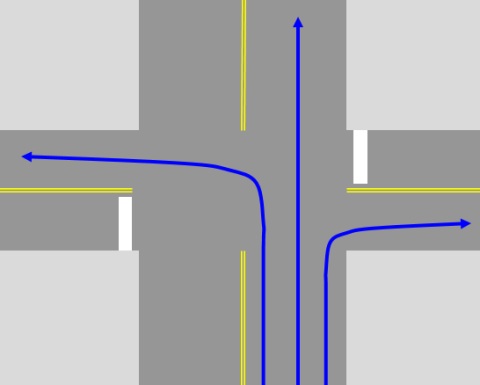5. Destination Positioning at Intersections
Drivers approach intersections using a lateral position that corresponds to their destination (see § 20-153). Left turning drivers approach in a position near the center of the road. Right turning drivers approach from a position near the right edge of the road. Straight traveling drivers choose a position between these extremes. Attempting to negotiate and intersection from the wrong position results in path conflicts, as shown below. This sometimes happen when motorists and bicyclists select a lateral position based on vehicle type rather than according to destination.
When motorists stop at an intersection with space between their vehicle and the road edge, some bicyclists may attempt to pass on the right and move up to the intersection. This can create a collision hazard with drivers who are about to turn right. Passing on the right is unlawful in North Carolina except when done in a separate marked lane.
One way that right-turning drivers can deter this hazard is to merge all the way to the right edge of the road when approaching the right turn. Wait for a gap in any bicycle traffic on the right, and merge safely into position for a right turn. This may be done even if there is a marked bicycle lane. Being all the way to the right, without room for right-side passing, allows the right-turning driver to focus on pedestrians and vehicles ahead without trying to scan their blind spot for overtaking bicyclists.
§ 20-153. Turning at intersections.
(a) Right Turns. – Both the approach for a right turn and a right turn shall be made as close as practicable to the right-hand curb or edge of the roadway.
(b) Left Turns. – The driver of a vehicle intending to turn left at any intersection shall approach the intersection in the extreme left-hand lane lawfully available to traffic moving in the direction of travel of that vehicle, and, after entering the intersection, the left turn shall be made so as to leave the intersection in a lane lawfully available to traffic moving in the direction upon the roadway being entered.
(c) Local authorities and the Department of Transportation, in their respective jurisdictions, may modify the foregoing method of turning at intersections by clearly indicating by buttons, markers, or other direction signs within an intersection the course to be followed by vehicles turning thereat, and it shall be unlawful for any driver to fail to turn in a manner as so directed.
§ 20-150.1. When passing on the right is permitted.
The driver of a vehicle may overtake and pass upon the right of another vehicle only under
the following conditions:
(1) When the vehicle overtaken is in a lane designated for left turns;
(2) Upon a street or highway with unobstructed pavement of sufficient width
which have been marked for two or more lanes of moving vehicles in each
direction and are not occupied by parked vehicles;
(3) Upon a one-way street, or upon a highway on which traffic is restricted to
one direction of movement when such street or highway is free from
obstructions and is of sufficient width and is marked for two or more lanes
of moving vehicles which are not occupied by parked vehicles;
(4) When driving in a lane designating a right turn on a red traffic signal light.



